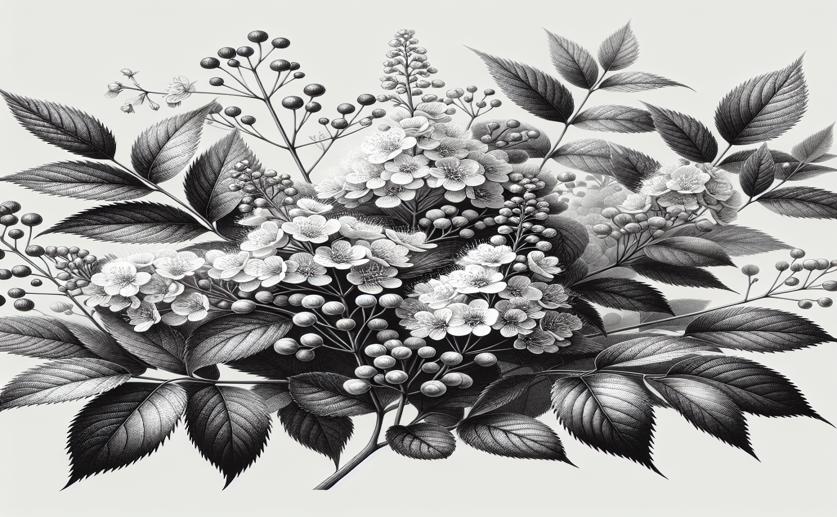Unveiling the Chemical Secrets of a Japanese Spi
rea's Flowers and Leaves

Image Source: Natural Science News, 2024
Tucked away in the vast tapestry of traditional Chinese medicine lies a plant whose unsung chemical constituents are just beginning to capture the attention of modern science. Spiraea japonica var. fortunei, a species lush with history and medicinal potential, has offered up its secrets bit by bit, chiefly known for its bountiful alkaloids—those nitrogen-bearing compounds often praised for their pharmacological effects. Yet, it is the plant's phenolic compounds, a diverse group of chemicals with their own impressive array of biological activities, that have recently stepped into the spotlight due to a groundbreaking study.
What's the big deal about these phenolic compounds, you might wonder? Well, these versatile molecules are something of a big deal in the plant kingdom, contributing to the plants' colors, taste, and resistance to diseases, among many other functions. More excitingly, when they find their way into our system, they can act as antioxidants, helping to neutralize harmful free radicals that can damage our cells and lead to chronic diseases.
Researchers, hailing from the Department of Chemistry at Sakarya University, took on the task of diving deep into the plant's phenolic profile. They set their sights on the leaves and flowers of Spiraea japonica var. fortunei, aiming to decode their molecular nuances both qualitatively and quantitatively. Qualitative analysis gives us the "what is it?"—the types of compounds present—while quantitative analysis answers the "how much?"—pinning concrete numbers on these compounds' presence.
Imagine the scientists meticulously grounding the plant material, their lab filled with the fragrant aroma of crushed leaves and flowers. These were then subjected to extraction processes using two common solvents: ethanol and methanol. Picture these solvents as molecular sieves, each vying to capture the most phenolic compounds from the plant tissues.
It was methanol, a simple alcohol, that emerged as the champion, proving to be a more efficient extractor than ethanol. The results were striking—particularly when it came to the leaves, which revealed themselves as a veritable treasure trove of phenolic compounds when compared to the flowers. Methanol didn’t just pluck more phenolics from the leaves; it hugged those compounds closely, boasting a total phenolic content of an impressive 25.64 milligrams per gram of dried plant material.
But the researchers weren't just counting milligrams. They tested the antioxidant activity of these extracts too, pitting them against a well-known free radical in a battle of molecular attrition. With a scientific flourish, they used the DPPH method—an assay that puts the spotlight on a compound's ability to quench free radical activity. The extract from the leaves, not shy in the least, flaunted its antioxidant prowess by scoring a 69.76% inhibition rate against these pesky radicals.
The phenolic victory dance didn't stop there. Armed with UV-VIS spectroscopy and FTIR analyses—techniques akin to giving molecules a unique fingerprint—the presence of phenolic compounds was confirmed with spectral evidence. The plant samples, now just an array of peaks and valleys on a graph, showed without a doubt: phenolics were here, and in abundant variety.
Things got even more detailed when they brought out the big guns: liquid chromatography-mass spectrometry, or LC-MS, which is kind of like giving each molecule a thorough interrogation under the good cop/bad cop routine of positive and negative ionization. Using this state-of-the-art technique, the team identified not one, not ten, but a total of 55 phenolic compounds skulking within the plant matter—each one possibly holding the key to new pharmaceutical and medicinal applications.
This study is much more than a simple scavenger hunt for plant compounds. It is a fusion of traditional knowledge and cutting-edge science, revealing that within the leaves and flowers of Spiraea japonica var. fortunei lies a complex chemical ecosystem waiting to be understood and harnessed. It is also a testament to the plant's untold potential—a potential that, until now, had been overshadowed by its more famous alkaloid relatives.
So the next time you see traditional medicine mentioned, it's worth remembering that these aren't just old wives' tales. With modern scientific tools at our disposal, we're finding a wealth of medical promise nestled within nature. And who knows? Maybe the next big breakthrough in our battle against diseases could be hidden within the leafy embrace of Spiraea japonica var. fortunei.
BiotechBiochemPlant Science
References
Main Study
1) Analyses of phytochemical compounds in the flowers and leaves of Spiraea japonica var. fortunei using UV-VIS, FTIR, and LC-MS techniques.
Published 15th February, 2024
https://doi.org/10.1016/j.heliyon.2024.e25496
Related Articles





 8th February, 2024 | Jim Crocker
8th February, 2024 | Jim Crocker